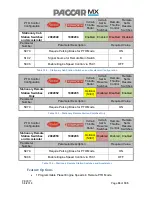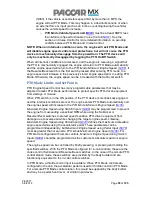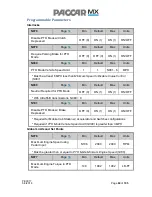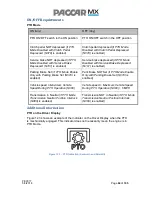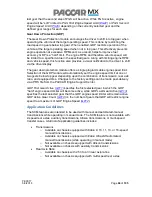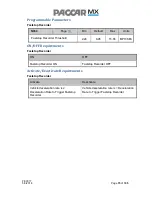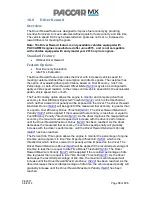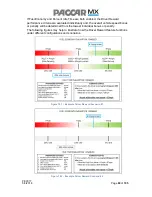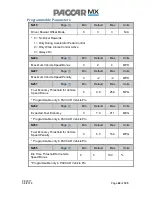
PEC017
5/3/2018
Page
67
of
105
15.0
Speed Control Management (SCM)
Overview
The Speed Control Management (SCM) feature is intended to help encourage fuel-
efficient shifting habits by reducing engine performance or restricting vehicle speed
at elevated engine speeds. Speed Control Management consists of two control
strategies: Progressive Shift (PGS) and Gear Down Protection (GDP), which may be
enabled separately or in combination.
PACCAR offers pre-approved and validated PGS and GDP settings for most manual
and automated-manual transmission powertrain configurations. Upon selection of at
least one of the SCM features, optimized shift points and the gears in which SCM
functionality will be active are identified by PACCAR and programmed into the
vehicle. These shift points are based on the customer’s powertrain configuration and
requested performance optimization goals.
Standard Feature
Without SCM
Feature Options
Progressive Shift
Gear Down Protection
Progressive Shift and Gear Down Protection
Progressive Shift (PGS)
The Progressive Shift module is typically used to encourage earlier shifts in lower
gears to improve fuel economy. By shifting earlier, the engine speed is reduced,
improving fuel economy. PGS is a “soft” RPM limit that restricts the rate of engine
acceleration when the engine speed is above a predefined engine speed limit. This
provides a balance between encouraging a driver to shift at lower engine speeds and
the driver
’s needs to remain in a gear longer to execute a shift under heavy load
and/or on a hill. The driver’s perception of the restricted engine acceleration gives a
clear indication to execute an upshift. Full engine acceleration is restored after the
driver executes a shift where the engine speed falls below the customer-defined limit
in the next gear. Along with limiting engine acceleration, this function also provides a
visual notification to the driver to shift via the driver display.
The Progressive Shift module will provide up to two engine speed limits, allowing
customers to use a more aggressive limit in lower gears and a less aggressive limit
in higher gears. 10-speed and 13-speed transmissions will receive a two-step engine
speed limit, and 18-speed transmissions will receive a single step. The first and last
gear in which each progressive shift range is programmed ensuring it is properly
configured to the customer’s application and for the specified powertrain
components.
specifies the number of distinct speed steps desired.
indicates the first gear number in which PGS will
become active and
indicates the last gear the the
first PGS step will be active.
PGS Second Engine Speed Limit (
defines the
engine speed threshold for the shift advisor.
specifies the

